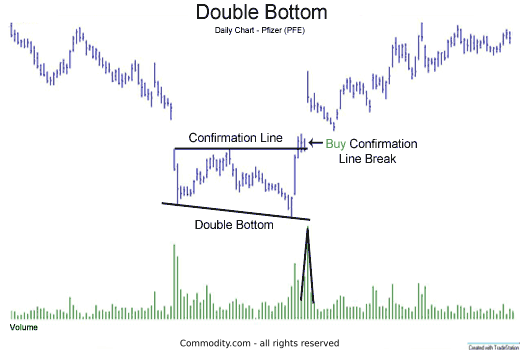In this guide to understanding the Double Bottom charting pattern, we’ll show you what this chart looks like and how to interpret it.
Contents
What Is the Double Bottom Pattern?
The Double Bottom technical analysis charting pattern is a common and highly effective price reversal pattern.
Chart 1 below of the Dow-Mini future illustrates the Double Bottom reversal pattern:

To create a double bottom pattern, price begins in a downtrend, stops, and then reverses trend. However, the reversal to the upside is short-term.
The price breaks again to the downside only to stop again and reverse direction upwards. With the second bottom of the double bottom pattern, it is usually more bullish if the second low is higher than the first low.
How to Interpret the Double Bottom Chart
A potential buy signal is given when the confirmation line is penetrated to the upside. The confirmation line is drawn across the top of the double bottom pattern (see Chart 1 above).
Retracement
Often, after price penetrates the confirmation line, price will retrace for a short time, sometimes back to the confirmation line. This retracement offers a second chance to get into the market long.
Volume
Volume also plays an important part of interpreting the Double Bottom pattern; this is illustrated in Chart 2 below of Pfizer (PFE):

Generally, volume should explode when the confirmation line is penetrated as it did in the chart of Pfizer (PFE).
Similar Patterns
- Another similar and popular bottom reversal pattern is the Reverse Head & Shoulders Pattern.
- The opposite of the Double Bottom is the bearish Double Top pattern.
Regulated Brokers: Where Can I Trade Commodities?
Start your research with reviews of these regulated brokers available in .
CFDs are complex instruments and come with a high risk of losing money rapidly due to leverage. Between 74%-89% of retail investor accounts lose money when trading CFDs. You should consider whether you can afford to take the high risk of losing your money.
Further Reading
Learn more about technical analysis indicators, concepts, and strategies including:


